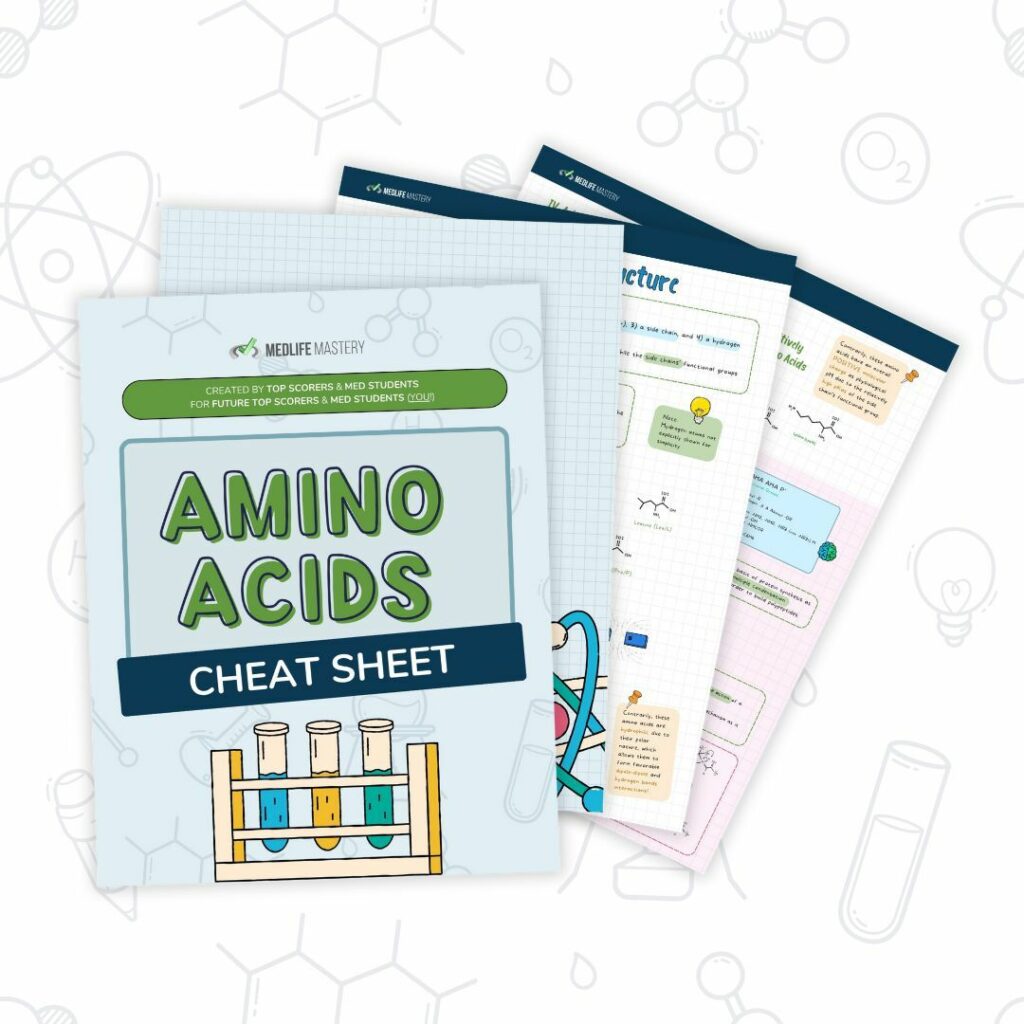Lipids are one of the four major macromolecules. They function to provide energy storage, membrane structure, and are an important component of hormones.
LIpids often have a bad reputation when it comes to dieting. However, they play a crucial role in cellular and structural integrity and metabolism. We require an adequate amount of fat to maintain physiological homeostasis.
Now that we know the fundamental functions and importance of lipids, and its metabolism, we can dive a little further into looking at key terms, definitions, and topics that will be important for the MCAT.
Let’s get started!
Lipid and Lipid Metabolism on the MCAT: What You Need to Know
Introductory biochemistry accounts for 25% of the Biological and Biochemical Foundations of Living Systems section (Bio/Biochem) and 25% of the Chemical and Physical Foundations of Biological Systems section (Chem/Phys).
Questions pertaining to lipids and/or its metabolism will likely appear in the Chem/Phys and Bio/Biochem sections. It is important to identify the several types of lipids by their molecular structural characteristics, as well as their functional characteristics. Specifically, in the Bio/Biochem section, it will be important to understand where anabolism and catabolism of lipids occur, how it occurs, and what primary enzymes are used.
Luckily for you, this review will give you a concise yet comprehensive review of lipids you are required to understand!
Let’s get started!
Important Sub-Topics - Lipid and Lipid Metabolism
Fatty Acids: Structural Description and Function
Fatty acids are long hydrocarbon chains with a carboxyl group (—COOH) at the end. Fatty acids can be categorized as saturated (no-double bonds in the hydrocarbon chain) or unsaturated ( ≥1 double bond(s) in the hydrocarbon chain).

Fatty acids have several functions, including:
1. Making up cellular membranes (phospholipids)
2. Aids in maintaining cell membrane fluidity
3. Energy storage (triglycerides/triacylglycerol)
Full Study Notes : Fatty Acids: Structural Description and Function on the MCAT
For more in-depth content review on fatty acids' structural description and function, check out these detailed lesson notes created by top MCAT scorers.
Fatty Acids: Digestion, Transport, and Mobilization
Fatty acids are primarily digested in the small intestines via pancreatic lipase and cholesterol esterase, which metabolize triglycerides and cholesterol esters, respectively.
Bile, which is made of bile salts, cholesterol, and bilirubin, helps to emulsify fat by increasing its surface area. This makes it easier for enzymes to digest fats.
The transportation of fats in the blood must be assisted by lipoproteins due to the non-polar nature of fats and the polar nature of blood. Lipoproteins are composed of a hydrophilic exterior (phospholipids and proteins) and a hydrophobic interior.
The 4 types of lipoproteins are:
1. Chylomicrons
2. Very low density lipoproteins (VLDL)
3. Low density lipoproteins (LDL)
4. High density lipoproteins (HDL)
The mobilization of lipids are required for the metabolism and storage of energy. Mobilization is carried out via hydrolysis of triglycerides, using enzymes like hormone sensitive lipase (HSL) and lipoprotein lipase (LPL).
Full Study Notes : Fatty Acids: Digestion, Transport, and Mobilization on the MCAT
For more in-depth content review on fatty acids' digestion, transport and mobilization, check out these detailed lesson notes created by top MCAT scorers.
Fatty Acids: Anabolism and Catabolism
Anabolism | Catabolism |
|---|---|
The synthesis of fatty acids, which primarily occurs in the cytosol of liver and adipose cells. | The breakdown of fatty acids, which occurs in the mitochondria of cells. |
Full Study Notes : Fatty Acids: Anabolism and Catabolism on the MCAT
For more in-depth content review on fatty acids' anabolism and catabolism, check out these detailed lesson notes created by top MCAT scorers.
Ketone Bodies: Function and Metabolic Reactions
Ketones bodies are an alternative energy source during prolonged periods of starvation or carbohydrate restriction.
The 3 ketone bodies are:
1. Acetoacetate
2. Beta-hydroxybutyrate
3. Acetone
Ketogenesis is the formation of ketone bodies, which primarily occurs in the mitochondria of liver cells. Whereas ketolysis is the breakdown of ketone bodies, which occurs in ketolytic organs; such as the brain, heart, and skeletal muscle.
Full Study Notes : Ketone Bodies: Function and Metabolic Reactions on the MCAT
For more in-depth content review on ketone bodies' function and metabolic reactions, check out these detailed lesson notes created by top MCAT scorers.
Metabolism of Proteins
Proteins are digested primarily in the stomach, via peptidases and hydrochloric acid.
Some common peptidases include:
1. Pepsin (stomach enzyme)
2. Trypsin (small intestinal enzyme)
3. Carboxypeptidase (small intestinal enzyme)
Other than building muscle, proteins can enter cellular, biochemical pathways to form ketone bodies as well as gluconeogenic substrates after deamination.
Full Study Notes : Metabolism of Proteins on the MCAT
For more in-depth content review on metabolism of proteins, check out these detailed lesson notes created by top MCAT scorers.
Important Definitions and Key Terms - Lipid and Lipid Metabolism
Term | Definition |
|---|---|
Saturated Fatty Acids | Identifies the presence of ≥1 double bond(s) in the hydrocarbon chain of a fatty acid. |
Unsaturated Fatty Acids | Identifies the lack of a double bond in the hydrocarbon chain of a fatty acid. |
Monounsaturated | Identifies one double bond in the fatty acid chain. |
Polyunsaturated | Identifies the presence of >1 double bond in the fatty acid chain. |
Hydrophobic stacking | The adjacent orientation of fatty acid chains, which decreases the fluidity of a structure. |
Triglycerides/Triacylglycerols | Composed of a glycerol esterified to 3 fatty acids. This is the primary molecule with which fat is stored. |
Pancreatic Lipase | An enzyme produced by the pancreas and secreted into the small intestines, which breaks down triglycerides. |
Cholesteryl esterase | An enzyme produced in the pancreas and secreted into the small intestines, which breaks down cholesterol. |
Emulsification | The process of increasing the surface area of fats in the small intestines by breaking them down into smaller droplets, making it easier for enzymes to digest fats. |
Chylomicrons | A lipoprotein with the lowest percentage of protein. The primary lipoprotein that transports fats from the small intestines to the lymphatic system and ultimately the circulatory system. Primarily carry triglycerides to the tissue. |
Very low density lipoprotein (VLDL) | A lipoprotein with the second lowest percentage of protein. Primarily carry triglycerides to tissues. |
Low density lipoprotein (LDL) | A lipoprotein with the second highest concentration of protein. Primarily delivers cholesterol to tissue. |
High density lipoprotein (HDL) | A lipoprotein with the highest concentration protein. Primarily delivers cholesterol to the liver. |
Hormone Sensitive Lipase (HSL) | Hydrolyzes intracellular/stored triglycerides for mobilization. |
Lipoprotein lipase (LPL) | Hydrolyzes triglycerides present in lipoproteins. |
Anabolism | The synthesis of some substance. |
Catabolism | The breakdown of some substance. |
Ketogenesis | The synthesis of ketone bodies. |
Ketolysis | The breakdown of ketone bodies. |
Deamination | The removal of the amino group from an amino acid to form urea, which can be excreted by the kidney. |
Additional FAQs - Lipids and Lipid metabolism
What are sphingolipids for the MCAT?
What are the main types of lipids?
Structure: Made of 1 glycerol esterified to 3 fatty acids tails. Non-polar.
Function: Provide energy, insulation, and storage of fatty acids.
2. Phospholipids:
Structure: Made of 1 glycerol backbone esterified to 2 fatty acid tails and 1 phosphate group. Amphipathic.
Function: Makes up the primary component of the lipid bilayer of cell membranes.
3. Sphingolipids:
Structure: Sphingosine backbone amide bonded to a fatty acid tail. Amphipathic.
Function: Maintains the structural integrity of cell membranes.
4. Terpenes:
Structure: Made of 1 or more isoprene (C5H8) units.
Function: Precursors to cholesterol and steroid hormones.
5. Cholesterol :
Structure: 4-ringed structure.
Function: Crucial for hormone synthesis, and maintains membrane stability and fluidity.
6. Waxes:
Structure: Esterified alcohol and fatty acid. Non-polar.
Function: Water repellent.
What is the metabolic process of lipids?
Prior to beta-oxidation:
1. Fatty acids → Fatty acyl-CoA via Fatty Acyl CoA Synthetase. This requires 1ATP.
Now the fatty acid is considered activated and can enter the mitochondria for beta-oxidation.
Beta-Oxidation:
1. Oxidation
Oxidation introduces a trans double bond between the alpha and beta carbon of the acyl chain.
FAD+→FADH2
2. Hydration
Addition of H2O forms an alcohol on beta carbon.
3. Oxidation
The alcohol formed in step two is oxidized into a carbonyl.
NAD+ → NADH
4. Thiolysis
A thiolase enzyme cleaves the bond between the alpha carbon and beta carbon (with the C=O) and produces an acteyl-CoA and an acyl-CoA that is 2 carbons shorter than the original molecule that entered beta oxidation. The acetyl-CoA is shuttled into the krebs cycle to produce ATP.
The cycle repeats until the fatty acid has been completely reduced to acetyl-CoA (for fatty acids with an even number of carbons) or propionyl-CoA (for fatty acids with an odd number of carbons).
E.g. In an 18 carbon fatty acid 9 acetyl-CoAs, 8 NADH and 8 FADH2 will be produced.
Is fatty acid synthesis on the MCAT?
Steps include:
1. Citrate Shuttle
2. Malonyl Co-A Formation (via Acetyl-CoA carboxylase)
3. Fatty acid Synthesis
Additionally, it is important to remember that fatty acid synthesis requires the use of NADPH.
What is lipid metabolism and lipid breakdown?
Additional Reading Links – Study Notes for Lipids and Lipid Metabolism on the MCAT
For more in-depth content review about lipids and lipid metabolism on the MCAT, check out these detailed lesson notes created by top MCAT scorers!
Additional Reading: Biochemistry Subjects on the MCAT:
- Biological Membranes on the MCAT
- Carbohydrate Metabolism on the MCAT
- Carbohydrate Structure on the MCAT
- DNA and RNA on the MCAT
- Enzymes on the MCAT
- Amino Acids Peptides Proteins on the MCAT
- Non-Enzymatic Proteins on the MCAT
- Regulation of Metabolism on the MCAT
- Biotechnology on the MCAT
- Bioenergetics on the MCAT



 To help you achieve your goal MCAT score, we take turns hosting these
To help you achieve your goal MCAT score, we take turns hosting these